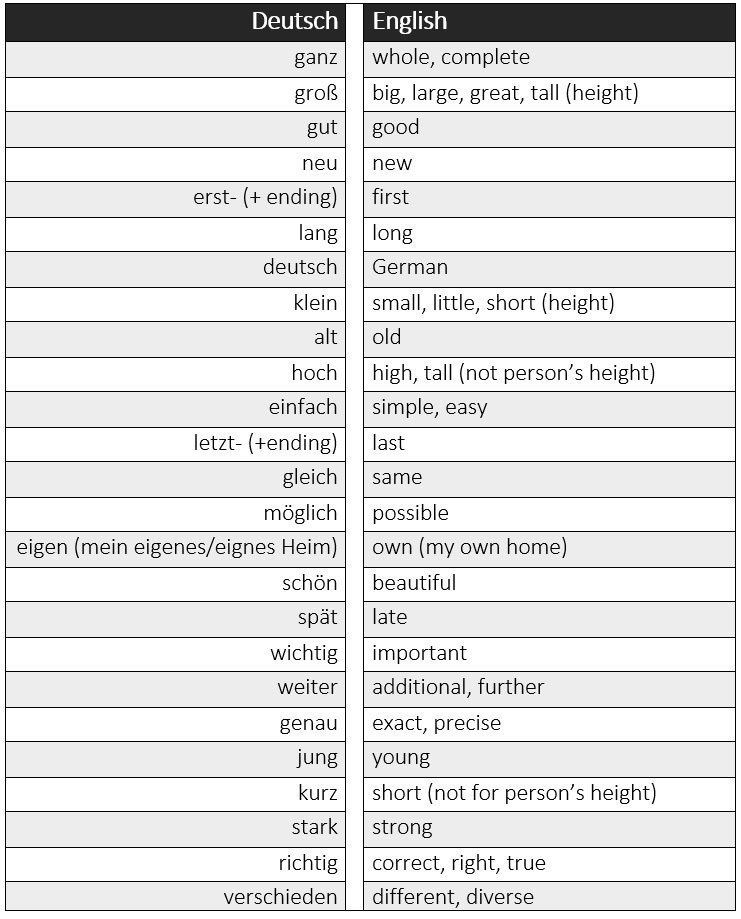Similar Germanic strong verb, German pronouns, German conjugation | ||

German adjectives come before the noun, as in English and (usually) are not capitalised. However, as in French and other Indo-European languages (but not English), they are generally inflected when they come before a noun: they take an ending that depends on the gender and case of the noun phrase.
Contents
- Strong inflection
- Mixed inflection
- Weak inflection
- No inflection
- Criteria for inflection
- Positive form
- Comparative form
- Superlative form
- References
The type of article or determiner preceding the noun also affects the inflection: in German, 'a red book' (indefinite article) and 'the red book' (definite article) = have different adjective endings:
Like articles, adjectives use the same plural endings for all three genders, though this does vary with the article or determiner as described above.
Participles may be used as adjectives and are treated in the same way.
German adjectives are declined only when they come before the noun which they describe. This is called the attributive position of a nominal phrase. Predicative adjectives, those in English separated from the noun by is or are, are not declined and are indistinguishable from adverbs, unlike in Romance and North Germanic languages.
There are some words that can be used as adjectives but are not inflected, such as Schweizer ("Swiss") and Jerusalemer ("pertaining to Jerusalem", for example Jerusalemer Kreuz).
There are three degrees of comparison: positive form, comparative form and superlative form: these correspond to (and have the same endings as) English equivalents such as 'large', 'larger' and 'largest'. 'Very loud' is said as sehr laut; as in English but unlike Italian and Latin, no ending exists to express this absolute superlative form as a single word.
Strong inflection
Strong inflection is used:
The adjective endings are similar to the definite article endings, apart from the adjectival ending "-en" in the masculine and neuter genitive singular.
Mixed inflection
Mixed inflection is used after:
Nominative and accusative singular endings are similar to the strong inflection; all other forms end with "-en".
Weak inflection
Weak inflection is used after:
Five endings in the nominative and accusative cases end with -e, all others with -en.
No inflection
Several quantifying words are not (always) inflected:
"wenig" and "viel" can be put in the plural, where they take endings as normal: viele/wenige Kinder
Criteria for inflection
German adjectives take different sets of endings in different circumstances. Essentially, the adjectives must provide case, gender and number information only if the articles do not. This is among the more confusing aspects of German grammar for those learning the language. However, the adjective endings nearly always adhere to the following rules:
Strong inflection
The strong inflection is used when there is no article at all, or if the noun is preceded by a non-inflectable word or phrase such as ein bisschen, etwas or viel ("a little, some, a lot of/much"). It is also used when the adjective is preceded merely by another regular (i.e. non-article) adjective.
Mixed inflection
The mixed inflection is used when the adjective is preceded by an indefinite article (ein-, kein-) or a possessive determiner.
Note: The prevailing view is that the mixed inflection is not a true inflection in its own right, but merely the weak inflection with a few additions to compensate for the lack of the masculine nominative and neuter nominative and accusative endings.
Weak inflection
The weak inflection is used when there is a definite word in place (der [die, das, des, den, dem], jed-, jen-, manch-, dies-, solch- and welch-). The definite word has provided most of the necessary information, so the adjective endings are simpler.
The endings are applicable to every degree of comparison (positive, comparative, and superlative).
Positive form
The basic form of the adjective is the positive form: the adjective stem with the appropriate ending.
schön (basic positive form)das schöne Lied ("the beautiful song")Comparative form
The basic comparative form consists of the stem and the suffix -er. Inflected, the corresponding adjective ending is attached.
schöner (basic comparative form)das schönere Lied ("the more beautiful song")Superlative form
A predicate form of the superlative is actually a prepositional phrase. One attaches the suffixes -st and the adjective ending -en to the root, and the word am is put before it.
am schönsten ("the most beautiful")Ich finde dieses Haus am schönsten. ("I find this house (to be) the most beautiful.")The attributive superlative form adds the "st" to the comparative root and then the conventional adjective ending.
das schönste LiedThis form can also be placed in a predicate position with the appropriate adjective ending:
Dieses Haus ist das schönste. ("This house is the most beautiful.")